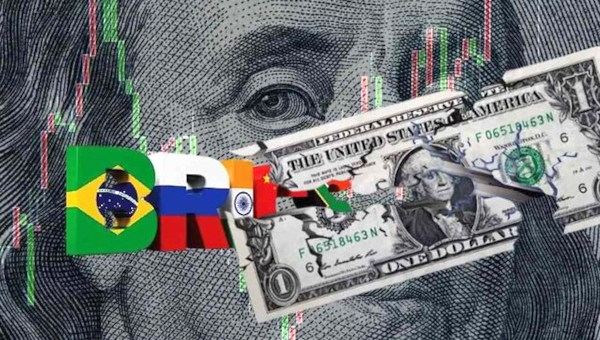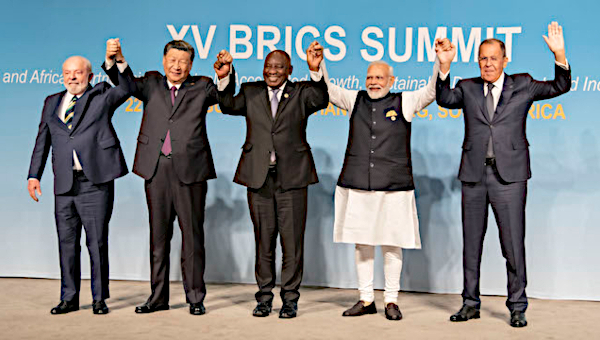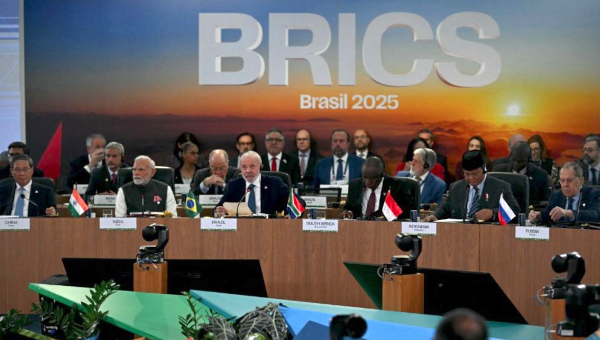The Sixth Summit of the BRICS (Brazil, Russia, India, China and South Africa) Heads of States, in Fortaleza, was accompanied by three others: the Business Meeting of BRICS, the Third Trade Union Summit and NGO’s and movement’s “Dialogues on Development: the BRICS from the perspective of peoples.” They are composed of actors from very different fields. They also represent projects that sometimes converge, and sometimes are in dispute regarding the development model, sustainability, social participation, equality and democracy, among other topics. These actors seek to be part of either the hegemonic or counter-hegemonic discourse, along and beyond the state. However, these “summits” are far from equal in terms of the ability to influence the way BRICS governments take their projects forward.
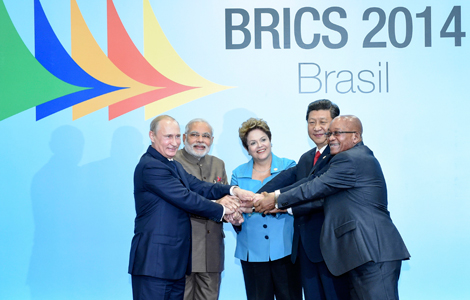 The first one took place one day before the meeting of presidents and was attended by approximately 700 business men and women.[1] The BRICS Business Meeting is the space where large companies from the five countries gather to attempt further integration of their business. They offered a series of recommendations aimed at the government summit, seeking to place the pro-corporate trade and investment position on the agenda. The following recommendations were made: visa facilitation for businessmen; reduction of non-tariff barriers; elimination of dumping and subsidies; creation of a “BRICS Business Portal” dedicated to information exchange; support for trade fairs, exhibitions and forums within the BRICS countries; a special section in the website of each country for commercial proposals to bring together potential business partners and joint ventures, among others.[2] Business actors also strongly support the creation of the BRICS New Development Bank, aimed at facilitating trade, business and investment, in addition to the potential increase in transactions in local currency (not the U.S. dollar), with the support of central banks for settlement of these currencies.[3] In these respects, the business agenda broadly coincides with the
The first one took place one day before the meeting of presidents and was attended by approximately 700 business men and women.[1] The BRICS Business Meeting is the space where large companies from the five countries gather to attempt further integration of their business. They offered a series of recommendations aimed at the government summit, seeking to place the pro-corporate trade and investment position on the agenda. The following recommendations were made: visa facilitation for businessmen; reduction of non-tariff barriers; elimination of dumping and subsidies; creation of a “BRICS Business Portal” dedicated to information exchange; support for trade fairs, exhibitions and forums within the BRICS countries; a special section in the website of each country for commercial proposals to bring together potential business partners and joint ventures, among others.[2] Business actors also strongly support the creation of the BRICS New Development Bank, aimed at facilitating trade, business and investment, in addition to the potential increase in transactions in local currency (not the U.S. dollar), with the support of central banks for settlement of these currencies.[3] In these respects, the business agenda broadly coincides with the
government’s one, as we see at the final declaration of Fortaleza and the agreement on the creation of the New Development Bank (NDB) and the Contingent Reserve Arrangement (CRA), which contemplate these recommendations.
Tripartite Convergence
At this point there is convergence between the governments of BRICS, businessmen and trade unions. Trade Union federations from the five countries, which met in Fortaleza the same day as the business meeting, declared their full support for the NDB as an instrument for the transformation of the global economic architecture. From the point of view of these unions, the BRICS represent a key step toward democratization of international relations and multipolarity.[4]
The business meeting also engaged in a formal Networking Session, where 600 companies from agribusiness, mining, infrastructure, pharmaceuticals, information technology, energy, green economy, and finance, did deals estimated to be worth $3.9-billion.[5] Finally, another area of business activity, created in Durban in 2013, is the BRICS Business Council, with direct and formalized dialogue with the governments of these countries.
A very different situation arises for unions, social movements and NGOs from the BRICS countries. In their declarations, unions expressed their claim to recognition of the BRICS Trade Union Forum as an institutional space within the formal structure of the group, as it is recognized for the Business Council. They also expressed their intention to participate in working groups and in the NDB in order to open space for social participation in the BRICS.[6]
Other movements, networks and NGOs joined the “Dialogues on Development: the BRICS from the perspective of the people” from 14 to 16 July, which I was able to attend in person. It was organized in conjunction with local movements in Fortaleza, one of the host cities of the World Cup, which concentrated a series of protests and social struggles in the last year.[7] The environment in Fortaleza had been radicalized previously to the Cup, and we can imagine that if the BRICS Summit occurred in March, as planned earlier, we would have had very large protests. However, as it took place immediately after the World Cup, the atmosphere was of relative exhaustion. The BRICS are not a topic of concern of Brazilian social movements, which have their own agendas, and thus would not attract a large mobilization. International issues are always distant from local movements’ agendas. The last breakthrough was the continental struggle against the Free Trade Area of the Americas ten years earlier, in bringing international issues to everyday life. The mobilizations around the meeting of the Inter-American Development Bank, held in Fortaleza in 2002, was another event protested by local social movements.
This time, civil society was led by the World March of Women, the Landless People’s Movement, the union federations CUT and CSP Conlutas, Jubilee South, the Articulation of Brazilian Women, the Popular World Cup Committee, Rede Brasileira pela Integração dos Povos, in addition to local organizations such as Instituto Terramar, Centro de Pesquisa e Assessoria, and collectives of communication, women and youth. Representatives of movements and NGOs from Africa, South America, Europe, Asia and the USA also participated. There were leaders from communities affected by mining in South Africa, academics and NGOs from China and India, as well as large international NGOs such as ActionAid. Support came especially from Germany’s Heinrich Boell Foundation (which provided two days of debate on the new BRICS Bank, bringing together academics and activists from China, India and South Africa) and Friedrich Ebert Foundation, as well as ActionAid. Brazilians were obviously in the majority, but we could also feel a great presence from South Africans, a lesser presence of Chinese and Indians, and regrettably, almost no presence from Russian activists.
The topics under debate varied widely: socio-environmental conflicts and inequalities, extractives, criminalization of social movements, social participation, human rights and transnational corporations, in addition to the central theme of the official summit, infrastructure and the New Development Bank (NDB). For this session, Ambassador Carlos Cozendey, the representative of the Brazilian government’s foreign ministry in NDB negotiations, entered into a dialogue with movements and NGOs.
View from Below
It is important to remember that Fortaleza was preceded by the meeting of social movements and organizations in Durban, South Africa, in 2013, which was called “BRICS from below.” This was sponsored by the Centre for Civil Society at the University KwaZulu-Natal, the South Durban Community Environmental Alliance and the NGO groundWork. It brought together grassroots social movements, NGOs and academics. Between Durban and Fortaleza, however, there were very few moments of articulation between the social bases of the BRICS countries. Indeed, a “BRICS from below” concept is a very recent process and its pace is slower than that of governments and business. The social realities in each country differ greatly, and language remains a problem (the common language is English, but it is inaccessible to communities and grassroots movements outside India or South Africa). What is understood as “civil society” (a concept that applies to business, if we follow the category of Gramsci), and how it relates to the state, is very different in each country.
There are many difficulties for Brazilian movements and NGOs to find common ground for dialogue with China and Russia organizations, for example. The latter tend to be very close to their governments, and they differ on issues such as the green economy, extraction or social participation. A dialogue with the South Africans is in some ways easier, and, in some cases, they have been established through international campaigns and protests for decades prior to the BRICS.
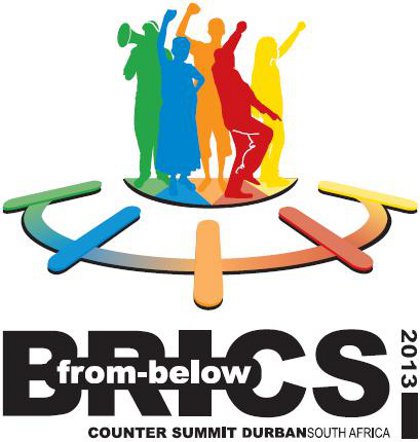 Interestingly, the theme “BRICS” is being explored in a more systematic way by agencies and NGOs “from the North” rather than “from the South.” For the latter, the group is still somewhat abstract, it is not realized in the struggles and social processes in the territories. What we see, rather, are South African, Brazilian, Chinese, Indian and Russian multinationals, mainly in the extractive sector, which have been generating negative impacts in the territories and in such cases, generating processes of resistance.
Interestingly, the theme “BRICS” is being explored in a more systematic way by agencies and NGOs “from the North” rather than “from the South.” For the latter, the group is still somewhat abstract, it is not realized in the struggles and social processes in the territories. What we see, rather, are South African, Brazilian, Chinese, Indian and Russian multinationals, mainly in the extractive sector, which have been generating negative impacts in the territories and in such cases, generating processes of resistance.
Despite the differences, we can identify some similar experiences of impacts, confrontation and resistance, plus themes that are common to all the people of the BRICS. There are, for example, experiences with mega-events and related violations of rights (the World Cup and Olympics in Brazil, China, South Africa and Russia, and Commonwealth Games in India). In the five countries, there are many instances of socio-environmental conflicts involving mega-projects of oil, gas and mining, and also rights violations around mega-infrastructure projects involving funding of national development banks. These will all likely be amplified by the future NDB. In other words, international solidarity and the processes of articulation and strengthen of societies in the BRICS will occur in processes of struggle, insofar as these countries move forward in the development model that they carry out today.
Different Views
One difficulty for cohesion and articulation of these social movements today is the fact that they have different views on the meaning of the BRICS in the world order. Some movements and organizations are closer to the positions of governments. They tend to characterize the BRICS more optimistically, as a possible alternative pole, balancing with Western powers, leading to a democratization of the world order so far under U.S. hegemony. Other movements and organizations are critical of their governments from various points of view, especially in the critique of the driving development strategies with high socio-environmental risk and little or no channel for effective social participation. Their view is that the BRICS are “more of the same” that is, a strengthening of global capitalism and the predatory accumulation of capital, not generating a real alternative to U.S. and global power.
This is reflected in distinct strategies toward the BRICS. Some demand an official space for the participation of civil society, trying to generate channels of influence from within. Others consider this strategy a lost game, given the disadvantageous correlation of forces within the BRICS, since governments have previously outlined their strategies. This position also points to the high risk of co-optation of these spaces of formal participation.
The NDB poses a major challenge to social movements and other civil society organizations. Only now it is possible to speak of the “BRICS” as a relatively coherent group, with an institution that identifies them. The NDB is still not in operation, but it is necessary to do a thorough analysis of the current capitalist order, in which the bank is situated, as well as of the strategies of these countries in the international financial architecture. The Brazilian government has insisted that the new financial mechanisms (NDB and CRA) are complementary to, not competing to the IMF and World Bank. Countries have the right to recall 30 per cent of the $100-billion they have allocated to the CRA, in case of problems in the balance of payments, but if they want to access the rest, they will have to rely on the approval of the IMF.
The NDB, in turn, will focus on infrastructure projects and sustainable development. But it is important to remember that the World Bank had already created, in 2013, the Global Infrastructure Facility (GIF), with strong support from Brazil, India and South Africa. The GIF proposal is to launch bonds in the international market to finance mega-projects.[8] If we take as an indicator the projects funded by the national development banks of the BRICS, such as Brazil’s Banco Nacional de Desenvolvimento Economico e Social (BNDES), we see that the supported projects prioritized major infrastructure (power plants, highways, ports), and not those that meet basic needs such as water and sanitation. The main beneficiaries are the big construction companies, in addition to giant mining and oil corporations. Thus, it strengthens a monopoly-capitalism that concentrates wealth within and outside the BRICS. How does the bank define “sustainable development.” Which criteria will be used for evaluating social and environmental impacts and which mechanisms of transparency decide which projects are to be financed with public funds? These questions need to be seriously addressed, since governments do not give answers to them.
Different Strategies
We cannot yet expect a unified position from social movements and other organizations toward the BRICS. Previous experiences, which were accumulated after numerous confrontations and dialogues with the World Bank, were very different. There are also a number of different relationships with the national development banks, which will reflect different strategies in confronting the new bank.
Some groups propose a dialogue and demand greater space to influence the bank’s policies. Oxfam, for example, has made recommendations to the bank, stating that “another bank is possible.”[9] In discussions in Fortaleza, some groups argued the need for guidelines and socio-environmental safeguards as criteria in projects financed by the NDB, in order to ensure that the minimum of safeguards already achieved in the World Bank, IDB and in other cases. A step back in the normative sphere would be a setback in the fight for human rights.
Yet it seems necessary to consider the previous experiences more systematically and judge where and when, for example, safeguards and guidelines for projects funded by the World Bank really did guarantee human, social and environmental rights in the territories. It is also important to base strategies upon accumulated experiences of struggle over influencing national development banks. In Brazil, NGOs and social movements have carried out for many years the “BNDES Platform.” Strategies of action and influence against financial actors are not new. The challenge ahead is forging unifying strategies within BRICS around the NDB.
BRICS governments, financial institutions and major economic groups (the BRICS from above[10]) progress according to the convergence between the state and capital, as they take forward accumulation strategies that worsen the concentration of wealth. It is necessary to build a true BRICS from below, with common strategies to fight for rights and international solidarity from the bases in BRICS countries. It will be successful only if built upon processes of social struggles and common experiences. Fortaleza is still a beginning. •
Text prepared for the blog of the research group Middle Powers in July 2014. I thank Patrick Bond for additional comments and English review.


